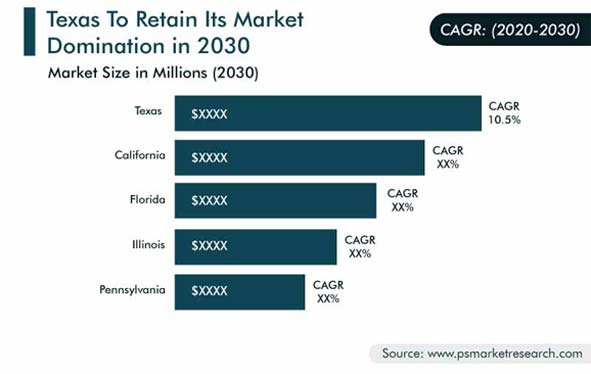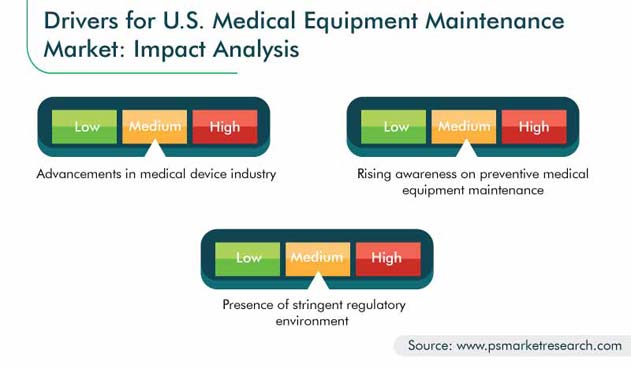Report Code: 11592 | Available Format: PDF | Pages: 121
U.S. Medical Equipment Maintenance Market Research Report: By Equipment Type (Imaging, Advanced Imaging Modalities, Primary Imaging Modalities, Electromedical, Life Support, Endoscopes, Surgical, Dental), Service Type (Preventive , Corrective, Operational), Service Provider (Original Equipment Manufacturer, Multi-vendor OEM, Single-Vendor OEM, Independent Service Organization, In-House Maintenance), End User (Public Sector, Private Sector) - Industry Analysis and Growth Forecast to 2030
- Report Code: 11592
- Available Format: PDF
- Pages: 121
- Report Description
- Table of Contents
- Market Segmentation
- Request Free Sample
U.S. Medical Equipment Maintenance Market Overview
The U.S. medical equipment maintenance market size was $8,262.2 million in 2019, and it is expected to progress at a CAGR of 9.2% during the forecast period (2020–2030). This growth is expected to be driven by the advancements in the medical device industry, rising awareness on preventive medical equipment maintenance, and presence of a stringent regulatory environment in the country.
Due to the COVID-19 pandemic, the social distancing policies adopted by the federal, state, and local authorities in the country have impacted the face-to-face interactions typically conducted by sales representatives, medical science liaisons, and other field-based employees of pharmaceutical and medical device companies. The country’s government is currently focused on the economic and health threats due to COVID-19. In such a scenario, manufacturers of medical equipment and providers of maintenance services across the U.S. have been negatively impacted.

Imaging Equipment Is Largest Category in Industry
Based on equipment type, the U.S. medical equipment maintenance market has been categorized into imaging equipment, electromedical equipment, life support equipment, surgical equipment, dental equipment, and endoscopes. Among these, the imaging equipment category held the largest share in the U.S. medical equipment maintenance industry in 2019. The higher cost of imaging equipment compared to others and increasing adoption of imaging modalities, such as X-ray, computed tomography (CT), and ultrasound, for clinical applications are the key factors contributing to the largest share of this category in the U.S market.
Preventive Maintenance Expected To Be Largest and Fastest-Growing Category in Market
The preventive maintenance category held the largest share in the U.S. medical equipment maintenance market in 2019, on the basis of service type. The category is also expected to witness the highest CAGR during the forecast period. This can be attributed to the increasing adoption of annual maintenance contract (AMC) policies by hospitals and other end users in the country, due to the various benefits associated with them.
Private Sector Bifurcation To Hold Larger Share in 2030
Private-sector organizations, as an end-user, are expected to account for the larger share in 2030 in the U.S. medical equipment maintenance market. This can be mainly ascribed to the growing private-sector healthcare industry and increasing healthcare expenditure in the country. According to the Centers for Medicare & Medicaid Services (CMS), healthcare spending in the country increased by 4.6%, to $3.6 trillion in 2018, as compared to $3.5 trillion in 2017, or to $11,172 per person in 2018 from $10,739 per person in 2017.
Texas — Largest and Fastest-Growing Medical Equipment Maintenance Market in U.S.
Among all the states, Texas dominated the U.S. medical equipment maintenance market in 2019, and it is expected to witness the highest CAGR during the forecast period. This is mainly due to the presence of a significantly high number of hospitals in the state, coupled with the growing healthcare expenditure. State agencies, such as the Texas Health and Human Services Commission (HHSC), Texas Department of Aging and Disability Services (DADS), and Texas Department of State Health Services (DSHS), account for ~83% of all healthcare spending in the state annually.

Increasing Number of Multi-Vendor Contracts Is Key Market Trend
The end users in the medical equipment maintenance market of the country are becoming more inclined toward entering into multi-vendor contracts, in order to reduce the complexities and additional expenses associated with separate services provided under agreements with the manufacturers of medical equipment. For instance, Koninklijke Philips N.V. offers the RightFit portfolio of service agreements for patient monitoring and ultrasound machines. Under this service agreement, the consumer may opt for remote service support for the proactive monitoring of Philips and non-Philips imaging systems.

Advancements in Medical Device Industry Are Driving Market
In the U.S., a number of technologically advanced medical devices and related products are used by healthcare professionals and organizations to provide world-class facilities to patients. According to the Information Technology News in January 2020, healthcare professionals are looking forward to technological advancements, such as hyper automation, which includes machine learning and artificial intelligence (AI); and automatic relocation machinery. As these high-tech medical devices require regular maintenance, software updates, and other services, their increasing adoption is predicted to drive the market in the coming years.
Presence of Stringent Regulatory Environment To Boost Market Growth during Forecast Period
The U.S. has a stringent regulatory framework, which makes medical equipment maintenance a compulsory requirement for end users. As per the regulations, hospitals must follow original equipment manufacturers (OEMs)’ recommended preventive maintenance programs and procedures, unless a waiver has been executed and approved by the state department of health. With such regulations in place, the adoption of medical equipment maintenance services by hospitals and other healthcare facilities is likely to increase, which would drive the growth of the U.S. medical equipment maintenance market in the coming years.
| Report Attribute | Details |
Historical Years |
2014-2019 |
Forecast Years |
2020-2030 |
Base Year (2019) Market Size |
$8,262.2 Million |
Forecast Period CAGR |
9.2% |
Report Coverage |
Market Trends, Revenue Estimation and Forecast, Regulatory Framework, Segmentation Analysis, State-Wise Breakdown, Competitive Analysis, Companies’ Strategic Developments, Product Benchmarking, Company Profiling |
Market Size by Segments |
By Equipment Type, By Service Type, By Service Provider, By End User, By State |
Market Size of Geographies |
Texas, California, Florida, Illinois, Pennsylvania, Ohio, New York, Michigan, Georgia, Kansas |
Secondary Sources and References (Partial List) |
American Association for Accreditation of Ambulatory Surgery Facilities, American Hospital Association, Association for the Advancement of Medical Instrumentation, Centers for Medicare & Medicaid Services, Center for Devices and Radiological Health, Health and Human Services, International Association of Healthcare Central Service and Material Management, The Joint Commission, United States Food and Drug Administration, World Health Organization |
Explore more about this report - Request free sample
Market Players Gaining Competitive Advantage with Strategic Mergers and Acquisitions (M&A)
The U.S. medical equipment maintenance market is highly diversified, due to the presence of several key players. In recent years, major players in the market have taken several strategic measures, such as partnerships, M&As, and facility expansions, to gain a competitive edge. For instance, in February 2020, Agiliti Inc. acquired Mobile Instrument Service & Repair Inc., which services flexible and rigid endoscopes, powered surgical equipment, handheld general and laparoscopic instruments, video cameras and processing systems, case carts, and rolling stock sterilizers.
Similarly, in July 2019, Agiliti Inc. acquired Zetta Medical Technologies LLC, a provider of medical equipment services and parts based in Lake Zurich III, Switzerland. Through this acquisition, Agiliti Inc. aimed to expand into the full-service clinical engineering domain for high-end imaging devices.
Further, in December 2018, Federal Street Acquisition Corp. and Agiliti Holdco Inc. (a subsidiary of Agiliti Inc.) entered into an amended and restated merger agreement, under which both the companies agreed to reduce the aggregate consideration paid to the selling equity holders of Agiliti Holdco Inc., from approximately $1.58 billion to $1.44 billion.
Key Players in U.S. Medical Equipment Maintenance Market Include:
-
General Electric Company
-
Siemens AG
-
Koninklijke Philips N.V.
-
Drägerwerk AG & Co. KGaA
-
FUJIFILM Holdings Corporation
-
Hitachi Ltd.
-
Agfa-Gevaert N.V.
-
Agiliti Health Inc.
-
Canon Inc.
-
Carestream Health Inc.
-
Shimadzu Corporation
-
Sodexo Group
-
Crothall Healthcare
-
TRIMEDX Holdings LLC
-
Signature Medical Services Inc.
-
NovaMed Corporation
-
Diagnostic Equipment Service Corporation (DESCO)
U.S. Medical Equipment Maintenance Market Size Breakdown by Segment
The U.S. medical equipment maintenance market report offers comprehensive market segmentation analysis along with market estimation for the period 2014–2030.
Based on Equipment Type
- Imaging
- Advanced imaging modalities
- Computed tomography (CT)
- Magnetic resonance imaging (MRI)
- Primary imaging modalities
- Digital X-ray
- Ultrasound
- Advanced imaging modalities
- Electromedical
- Life Support
- Endoscopes
- Surgical
- Dental
Based on Service Type
- Preventive
- Corrective
- Operational
Based on Service Provider
- Original Equipment Manufacturer (OEM)
- Multi-vendor OEM
- Single-vendor OEM
- Independent Service Organization (ISO)
- In-House Maintenance
Based on End User
- Public Sector
- Private Sector
Geographical Analysis
- Texas
- California
- Florida
- Illinois
- Pennsylvania
- Ohio
- New York
- Michigan
- Georgia
- Kansas
The U.S. medical equipment maintenance market is expected to reach $21,358.3 million by 2030.
The U.S. medical equipment maintenance industry report covers Georgia, California, Illinois, Ohio, Michigan, Texas, Florida, Pennsylvania, Kansas, and New York.
Imaging equipment generated the highest revenue in the U.S. medical equipment maintenance industry in 2019.
An increase in healthcare spending and rise in the number of hospitals are expected to make Texas the largest medical equipment maintenance market in the U.S. during 2020–2030.
The stringent regulatory framework in the U.S. makes it mandatory for the end users to maintain their medical equipment.
Want a report tailored exactly to your business strategy?
Request CustomizationWant an insight-rich discussion with the report author?
Speak to AnalystOur dedication to providing the most-accurate market information has earned us verification by Dun & Bradstreet (D&B). We strive for quality checking of the highest level to enable data-driven decision making for you
Our insights into the minutest levels of the markets, including the latest trends and competitive landscape, give you all the answers you need to take your business to new heights
With 24/7 research support, we ensure that the wheels of your business never stop turning. Don’t let time stand in your way. Get all your queries answered with a simple phone call or email, as and when required
We take a cautious approach to protecting your personal and confidential information. Trust is the strongest bond that connects us and our clients, and trust we build by complying with all international and domestic data protection and privacy laws